Graph View tab
The
Graph View
displays graphs for the sensors selected in the
Widget Explorer pane
.
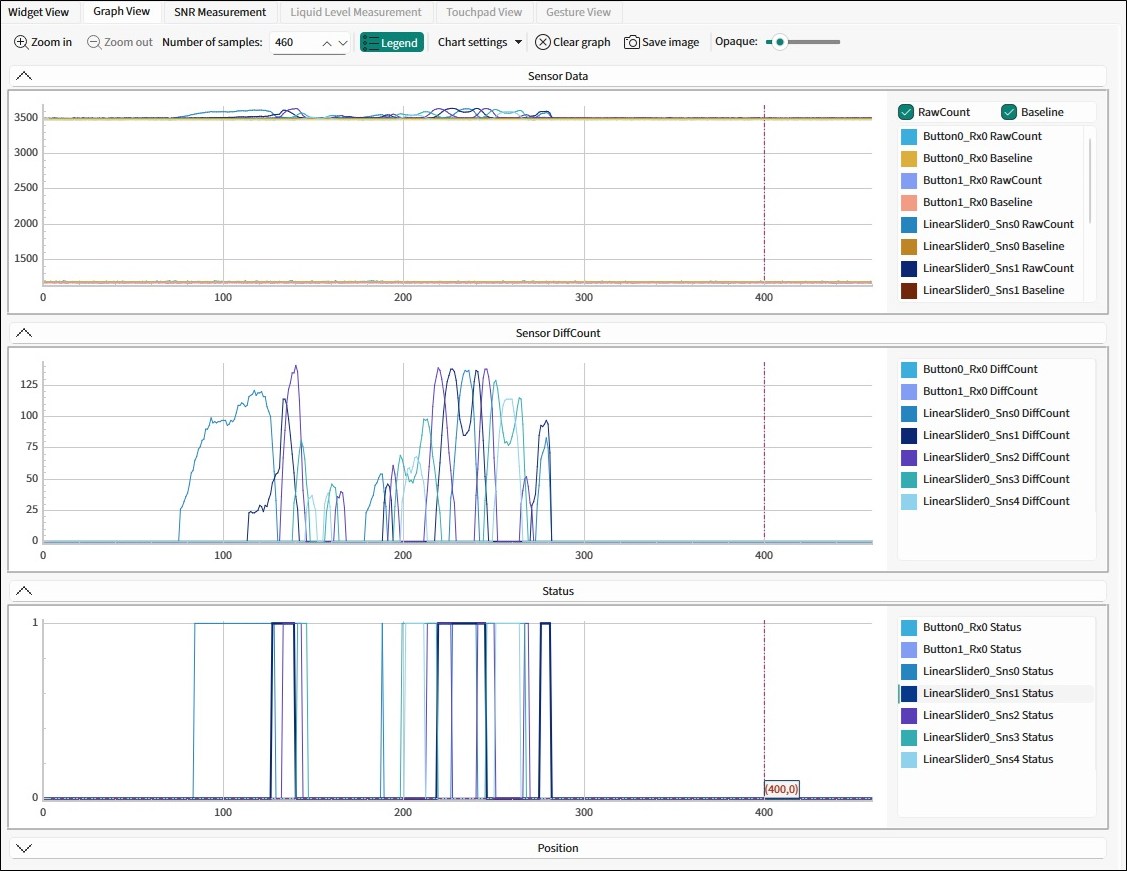
The following graphs are available:
Sensor Data – Displays RawCount and Baseline. Click a corresponding check box to see them. In Multi-frequency mode, RawCount and Baseline are available for three channels: 0, 1, 2.
Sensor DiffCount – Displays signal differences.
Status – Displays a sensor status (Touch/No Touch).
Position – Displays touch positions for the Linear Slider, Radial Slider, and Touchpad widgets.
Note:
For 5th generation CAPSENSE™ configuration with enabled Multi-frequency mode, there is a Median graph on the Sensor Signal graph for each sensor. For Multi-frequency mode, three varieties are scanned for each sensor at three different frequencies and three different raw-counts are obtained for the same sensor. The sensor state is estimated by one median value calculated from the obtained three raw-counts. A Median graph shows a set of F0 values received from a kit. The graph becomes visible if at least one of the graphs F0, F1, F2 is visible. Then, the Tuner calculates the actual value of F0 from received data.
Graph View tab toolbar
Go to the
Tabs toolbars
table to see the descriptions of the
Graph View
tab toolbar.
Also, you can left -click the
Chart settings
to see the menu for editing the chart line series parameters.
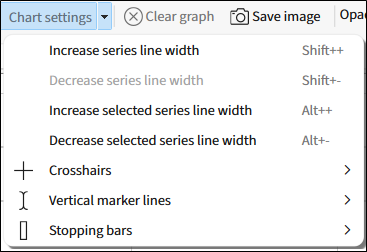
Crosshairs – Consists of two lines parallel to the coordinate axes. The vertical component always shows the X coordinate of the mouse cursor and moves with the mouse pointer synchronously on all four charts: Sensor Data , Sensor Signal , Status , and Position regardless of their scale and shift. The horizontal component is visible only on the chart (active chart) over which the mouse cursor is hovering. Right-click the Crosshairs to see the context menu options..
Vertical marker lines – When you left-click, the Tuner adds a Vertical marker line with a value equal to the X coordinate of the mouse cursor synchronously on all four charts – Sensor Data , Sensor Signal , Status , and Position regardless of their scale and shift. Press the [ Esc ] key to erase all previously drawn Vertical marker lines . You can change the characteristics of Vertical marker lines or disable them in the submenu Chart settings > Vertical marker lines .
Stopping bars – When performing Stop communication , the Tuner adds a rectangular mark after the current endpoint synchronously on all four charts. After a new start of communication, new chart points will be added after the last stopping bar. You can change the Stopping bars characteristics or disable them in the Chart settings > Stopping bars submenu.
Graph functionality
The Graph functionality includes:
Highlighting – If you click a sensor line series on the graph, the corresponding sensor series highlights on the Legend pane. Likewise, if you click a sensor series on the Legend pane, it highlights a sensor line series on the graph. To highlight lines for all graphs at the same time, press and hold the [ Ctrl ] key. To select multiple sensors in the other View tabs, press and hold the [ Alt ] key.
Pan and Zoom – Allow you to examine graphs in more detail.
Use a mouse drag for pan. Press and hold the [ Shift ] key to select the area you need to examine. Press and hold the [ Ctrl ] key to examine all the graphs simultaneously.
Use the mouse wheel for Zoom. The [ Ctrl ] key + mouse wheel zooms all graphs simultaneously. Press the [ Esc ] key to undo zoom and pan for all graphs
The context menu provides the options to change the appearance of graphs. To display the menu, right-click one of the charts: Sensor Data, Sensor Signal, Status, Position, or the chart's legend.
The context menu options are the same as for Graph View tab toolbar > Chart settings : Increase / Decrease series line width and Zoom.
The context menu for selected graphs ( Increase / Decrease selected series line width )also contains the Line style and Scatter shape options:
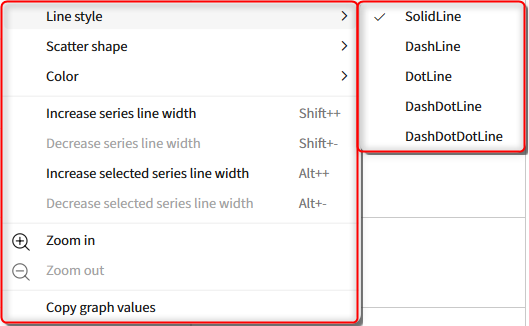
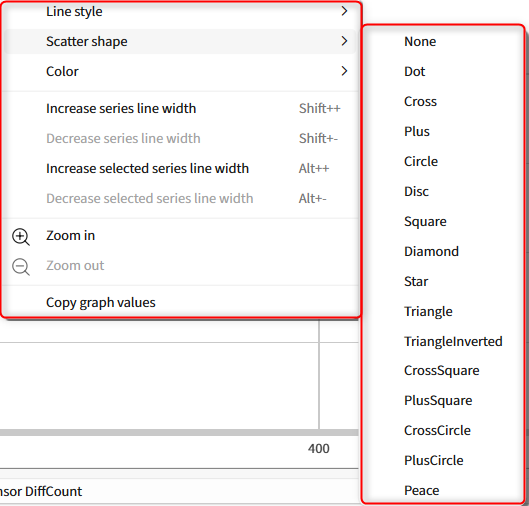
To change a sensor series color on the Legend pane, either double-click or right-click the sensor and select the Color option from the displayed menu. Select the widget for which to set the color.
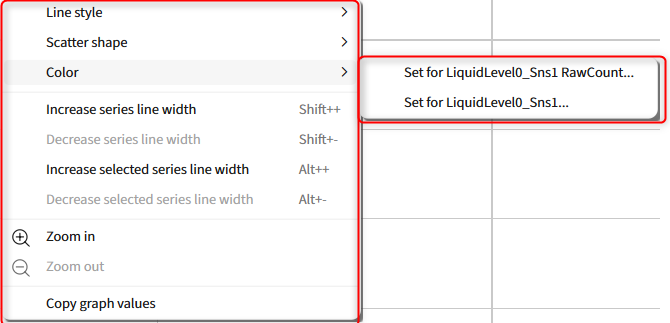
The "Please choose a color for …" dialog displays. You can change the color for the graph lines of the same sensor (widget) on all the charts of the Graph View and on the Touch Signal Graph of the Widget View simultaneously.
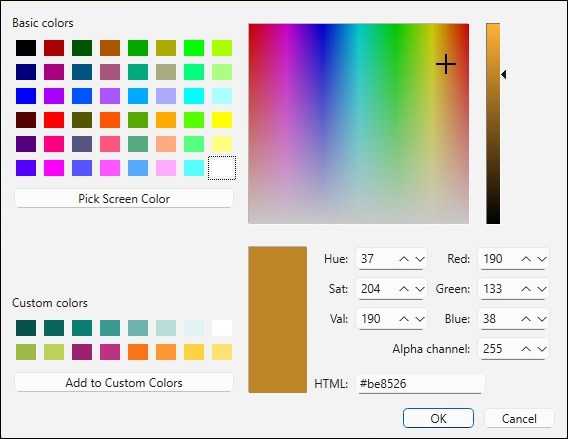
Select a color and click
OK
.To select a color for all the graphs at the same time, press and hold the [
Ctrl
] key while clicking.